Julia Buckley's Blog, page 8
July 18, 2013
Crime Writer John Barlow: Leeds and Crime Fiction
John Barlow is a British crime writer who has just released the second book in his LS9 Crime Series, called FATHER AND SON. In this guest blog, he explains why Leeds has been underused as a site for crime fiction.
 The case for Leeds
The case for Leeds
by John Barlow
Crime writers often base their novels in a specific place, and become identified with that city or area: Ian Rankin (Edinburgh), Peter James (Brighton), John Harvey (Nottingham), Peter Robinson (North Yorkshire), Ann Cleeves Northumberland, Shetlands), Nick Quantril (Hull). The new wave of self-published writers has continued this tradition: Kerry Wilkinson (Manchester), Bill Rogers (Manchester), Mel Sherratt (Stoke)...
The setting for these books become part of the works themselves, almost characters in the fiction. When you open a new novel by one of these writers, you sink back into the familiar atmosphere of a familiar place, just as you reacquaint yourself with the main character.
Looking back at that (very incomplete) list, there’s a lot of northern towns and cities. Whereas ‘literary’ fiction is often associated with the south, especially London, the same cannot be said of crime writing, where both Tartan and Northern Noir are squarely on the map.
Except for Leeds. England’s third largest city (after Birmingham and London) is more or less absent from the list. Sure, there’s David Peace. But his novels, for some reason, don’t resonate with the city in the same way as Ian Rankin’s do of Edinburgh. We do have Kate Atkinson’s STARTED EARLY, TOOK MY DOG there, but apart from that, Leeds really lacks a major presence in crime writing. Which is strange, because rival city Manchester is bursting with crime fiction, so much that at any moment we might expect the city’s Tourism Office to take out ads in the national press reminding people that this is fiction, and that Deansgate and Peter Street are not in fact littered with bleeding corpses.
A couple of years ago I wrote my first crime thriller, and decided to set it in Leeds. As part of the research for the book, I contacted the West Yorkshire Police, explained who I was, and was allocated an official contact on the city’s CID. I asked him what it was like working on serious crime in Leeds. The best place! he said, grinning. He went on to tell me how interesting and varied crime was in the city, and that for a CID officer there was no better posting.
I started to realise that Leeds was in fact perfect for crime fiction. It is large, with a varied economy and a rich social mix. There’s the broad swathe of 1960s social housing to the north of the city, which at one point included Quarry Hill, at the time the largest social housing project in the UK. Then, just a few miles further out are the millionaires’ residences and golf clubs of the city’s rich folk, many of whom are extremely rich, and absolutely fair game for any fictional criminal...
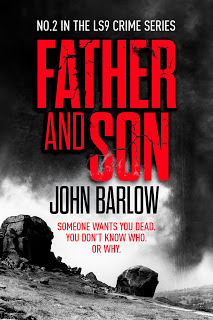 Leeds also has a long history of immigration, with a number of very well established ethnic communities. For example, when young Polish immigrants began to arrive in the city in recents years, they found the remnants of an earlier wave of Polish immigration, including social centres.
Leeds also has a long history of immigration, with a number of very well established ethnic communities. For example, when young Polish immigrants began to arrive in the city in recents years, they found the remnants of an earlier wave of Polish immigration, including social centres.
Then, inevitably, there’s the Ripper. The hunt for the Yorkshire Ripper was coordinated from Millgarth Police Station in Leeds city centre. It was a watershed in British policing, and showed how inadequate the investigative practices of the time were; at one point, the floor in Millgarth used to store the huge card index system for the Ripper inquiry had to be reinforced, since it was threatening to bring down the whole building.
A direct consequence of this was the HOLMES nation database, which figures in most police procedural novels these days, since all serious crime is entered into its vast digital store. Every police officer I have talked from the city to carries the Ripper investigation deep in their psyche, part of the DNA of policing there.
To say Leeds could be the new Edinburgh is not stretching the imagination. And given that the Harrogate Festival is just a bus ride away (OK, a short drive in your BMW), it seemed a good place to celebrate Leeds in all its (fictional) criminal glory. The Tartan lot may have had all the headlines up until now, but I think Northern Noir is ripe for a surge, with Leeds at the helm. I’m doing my bit, with a series set right in Leeds city centre. I don’t know to what extent this is a risk, but when the first novel came out, last year, a blogger from Australia not only reviewed the book, but wrote a piece about the city itself.
So, if you’re looking for a new destination in your crime reading, give Leeds a try. The streets are not littered with bleeding corpses just yet, but I’m doing my best.
John Barlow’s second novel set in Leeds, FATHER AND SON, is out now. Buy it here:Amazon(US)Amazon(UK) Or find him at his website, www.johnbarlow.net.

 The case for Leeds
The case for Leeds
by John Barlow
Crime writers often base their novels in a specific place, and become identified with that city or area: Ian Rankin (Edinburgh), Peter James (Brighton), John Harvey (Nottingham), Peter Robinson (North Yorkshire), Ann Cleeves Northumberland, Shetlands), Nick Quantril (Hull). The new wave of self-published writers has continued this tradition: Kerry Wilkinson (Manchester), Bill Rogers (Manchester), Mel Sherratt (Stoke)...
The setting for these books become part of the works themselves, almost characters in the fiction. When you open a new novel by one of these writers, you sink back into the familiar atmosphere of a familiar place, just as you reacquaint yourself with the main character.
Looking back at that (very incomplete) list, there’s a lot of northern towns and cities. Whereas ‘literary’ fiction is often associated with the south, especially London, the same cannot be said of crime writing, where both Tartan and Northern Noir are squarely on the map.
Except for Leeds. England’s third largest city (after Birmingham and London) is more or less absent from the list. Sure, there’s David Peace. But his novels, for some reason, don’t resonate with the city in the same way as Ian Rankin’s do of Edinburgh. We do have Kate Atkinson’s STARTED EARLY, TOOK MY DOG there, but apart from that, Leeds really lacks a major presence in crime writing. Which is strange, because rival city Manchester is bursting with crime fiction, so much that at any moment we might expect the city’s Tourism Office to take out ads in the national press reminding people that this is fiction, and that Deansgate and Peter Street are not in fact littered with bleeding corpses.
A couple of years ago I wrote my first crime thriller, and decided to set it in Leeds. As part of the research for the book, I contacted the West Yorkshire Police, explained who I was, and was allocated an official contact on the city’s CID. I asked him what it was like working on serious crime in Leeds. The best place! he said, grinning. He went on to tell me how interesting and varied crime was in the city, and that for a CID officer there was no better posting.
I started to realise that Leeds was in fact perfect for crime fiction. It is large, with a varied economy and a rich social mix. There’s the broad swathe of 1960s social housing to the north of the city, which at one point included Quarry Hill, at the time the largest social housing project in the UK. Then, just a few miles further out are the millionaires’ residences and golf clubs of the city’s rich folk, many of whom are extremely rich, and absolutely fair game for any fictional criminal...
 Leeds also has a long history of immigration, with a number of very well established ethnic communities. For example, when young Polish immigrants began to arrive in the city in recents years, they found the remnants of an earlier wave of Polish immigration, including social centres.
Leeds also has a long history of immigration, with a number of very well established ethnic communities. For example, when young Polish immigrants began to arrive in the city in recents years, they found the remnants of an earlier wave of Polish immigration, including social centres.Then, inevitably, there’s the Ripper. The hunt for the Yorkshire Ripper was coordinated from Millgarth Police Station in Leeds city centre. It was a watershed in British policing, and showed how inadequate the investigative practices of the time were; at one point, the floor in Millgarth used to store the huge card index system for the Ripper inquiry had to be reinforced, since it was threatening to bring down the whole building.
A direct consequence of this was the HOLMES nation database, which figures in most police procedural novels these days, since all serious crime is entered into its vast digital store. Every police officer I have talked from the city to carries the Ripper investigation deep in their psyche, part of the DNA of policing there.
To say Leeds could be the new Edinburgh is not stretching the imagination. And given that the Harrogate Festival is just a bus ride away (OK, a short drive in your BMW), it seemed a good place to celebrate Leeds in all its (fictional) criminal glory. The Tartan lot may have had all the headlines up until now, but I think Northern Noir is ripe for a surge, with Leeds at the helm. I’m doing my bit, with a series set right in Leeds city centre. I don’t know to what extent this is a risk, but when the first novel came out, last year, a blogger from Australia not only reviewed the book, but wrote a piece about the city itself.
So, if you’re looking for a new destination in your crime reading, give Leeds a try. The streets are not littered with bleeding corpses just yet, but I’m doing my best.
John Barlow’s second novel set in Leeds, FATHER AND SON, is out now. Buy it here:Amazon(US)Amazon(UK) Or find him at his website, www.johnbarlow.net.

Published on July 18, 2013 12:36
June 20, 2013
Anxiety, Imprisonment, and THE NEVER LIST
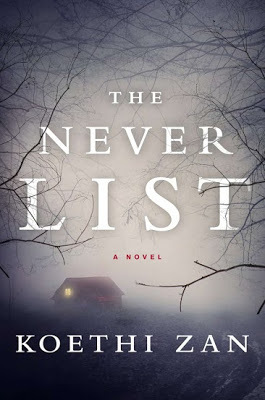 It was little more than a month ago that three women were rescued from a Cleveland, Ohio home, where they had been held for years against their will and where they were beaten, raped, and restrained in a dungeon-like basement. Koethi Zan's new thriller THE NEVER LIST has eerie parallels to that story, since it tells the tale of a woman who was held in similar captivity for three years, along with two other women.
It was little more than a month ago that three women were rescued from a Cleveland, Ohio home, where they had been held for years against their will and where they were beaten, raped, and restrained in a dungeon-like basement. Koethi Zan's new thriller THE NEVER LIST has eerie parallels to that story, since it tells the tale of a woman who was held in similar captivity for three years, along with two other women.The narrator of THE NEVER LIST is one of the captives, and she begins her tale by saying "There were four of us down there for the first thirty-two months and eleven days of our captivity."
Perhaps the most frightening thing about this book is that it doesn't even necessarily seem like fiction. Several high-profile rescues in the last ten years (notably two in Austria and two in California) involved similar kidnappings and imprisonments of women, sometimes for many years. One of the Austrian women, Elisabeth Fritzl, was imprisoned (by her own father) when she was eighteen and was only freed twenty-four years later, after giving birth to seven children sired by her father and suffering repeated abuse by him.
THE NEVER LIST, to my relief, does not so much detail the abuse that the prisoners received as it does examine the psychology of imprisonment--not only the motivation of the captor, but the many repercussions, physical and psychological, created by the loss of freedom.
The book's title emerges as a central irony of the novel--the narrator, Sarah, and her best friend, Jennifer, survive a car crash when they are young, after which, in their anxiety, they try to manage their lives by preventing any possible tragedies. They do this by creating THE NEVER LIST--what never to do if one wants to stay safe. Never walk alone, never trust a stranger, never park far from your destination, etc. When Jennifer and Sarah eventually become captives, Sarah is faced with the bitter truth: victimization is not necessarily something one can avoid by being vigilant.
Indeed, the notion of victimization is explored at length in this novel, in an interesting and compelling way. While I didn't always predict the direction that the novel would go and I found at least one event utterly unbelievable, I must admit that I read this book practically in one sitting, and it was truly compulsive reading.
Zan's premise is fascinating not only because she takes us inside the mind of one who has endured horror, but because she examines the reality of anxiety in teenagers. Recent studies have suggested that both anxiety and depression have increased at a rapid rate in young people, and I thought of that when I read Sarah's account of the time she spent with her teenage friend chronicling all possible disasters that could befall them and then making plans to avoid them. Their anxiety created a sort of agoraphobic avoidance, an imprisonment-before-their-imprisonment.
Sarah's narrative voice is compelling and heartbreaking, and her life after captivity makes the reader root for her even while they acknowledge that she can never be the same.
An interesting and sobering read.

Published on June 20, 2013 13:26
April 12, 2013
Marian Keyes on Beautiful Handbags, Clever Children, and Her Fun New Mystery
 Marian Keyes is one of the most successful Irish novelists of all time. Her new book, The Mystery of Mercy Close, is available in bookstores now.
Marian Keyes is one of the most successful Irish novelists of all time. Her new book, The Mystery of Mercy Close, is available in bookstores now.Hell, Marian! First, let me say that your book was a delight to read! I very much enjoyed The Mystery of Mercy Close.
Hello JuliaYour character, Helen, has a wonderful narrative voice—direct and spritely and likable. How do you keep her narration so full of energy? Did you hear her voice in your head while you were writing the novel?
The thing is that Helen has already appeared in 4 of my other books. There is a family of 5 sisters, and 4 of the other sisters have already had ‘their’ book and this was Helen’s turn. So in a way I already knew her voice. But it’s very different to mine so every time I sat down to write I had to ‘become’ Helen, like an actor preparing for a part. And I knew she was no-nonsense and slightly acerbic, so I had to divest myself of any sentimentality
Helen had two love interests in this novel, and they were both extremely attractive. One of them truly won my heart. Are you a romantic at heart? Do you like reading romantic stories?
I’m so glad you liked them! I’m interested in reading about relationships, all relationships and all my novels are about emotional landscapes. When I was a lot younger and studying law I got light relief by reading a couple of Harlequin-style romances every weekend. …I’m not so sure I could do that now. I’m not really a fan of books that present a man as the solution to all the heroine’s problems.
The premise of the mystery is that a former boy band member goes missing right before the band’s reunion. Do you have a favorite boy band that you would like to see reunited?
There’s an Irish boyband called BoyZone, I don’t know if you’ve heard of them? Also, I need to say I’m very fond of One Direction!
On your website you mention that one of your favorite artists is George Michael. If you could sing a duet with him, what would it be?
Oh, what a lovely thought! I’d happily sing anything with him! Perhaps Club Tropicana!
One of my favorite characters in Mercy Close is a nine-year-old girl named Bella, whose dialogue is routinely hilarious. Is she inspired by any real nine-year-olds, or did you just tap into your little-girl memories?
I will whisper this… Bella was inspired by 2 little girls I know. One is my niece, Ema, who was always incredibly bright and at the age of 4, her favourite movie was Roman Holiday. Even from a young age, I was able to have ‘grown-up’ conversations with her about movies and clothes and nail varnish. She took our discussions very seriously. The other inspiration for Bella is my god-daughter Kitten, who often does quizzes for me, the way Bella does for Helen.
The quiz was wonderful! (And I love the name Kitten). You have a law degree. If you practiced law today instead of writing your wonderful books, what would be your specialty?
Oooooh…. Tricky question. I feel so so so far away from the world of law that I couldn’t imagine practicing anything. I suppose I feel that the legal world is invoked to either anticipate a conflict or to resolve it and I’m a bit sappy. I like everyone to be nice!
 Helen struggles with anxiety and depression; at one point she confides to her doctor that she is waking up each day at 4:44. I’m curious to know if this is a real phenomenon, because I’ve had my share of panic attacks, and there was a point when I was also not only waking up at 4:44 each morning, but also seeing that number everywhere—on license plates, on billboards. Do you think this a number that stands out to anxious people?
Helen struggles with anxiety and depression; at one point she confides to her doctor that she is waking up each day at 4:44. I’m curious to know if this is a real phenomenon, because I’ve had my share of panic attacks, and there was a point when I was also not only waking up at 4:44 each morning, but also seeing that number everywhere—on license plates, on billboards. Do you think this a number that stands out to anxious people?VERY interesting point! They do say that, with human beings, our bio-rhythms make us most sad/fearful/vulnerable around 4 am. Without getting too morbid, it’s the time when ill people are most likely to die. There is so much anecdotal evidence that 4am-ish is when people wake to do their worrying that it must be true. I don’t think the fault lies with the numbers themselves, though, but the fact that our bodies and psyches are at their most depleted around then.
Helen’s descriptions of her depression is so detailed and realistic that I became depressed when reading some of the passages. How were you able to so well balance the darker side of Helen’s psyche with her fun, humorous narration?
It’s a feature of all my book that I balance serious issues with lots of humour. It was very important for me to write an accuture account of what it’s really like suffering from depression. However, I could only take so much darkness and I needed to write comedy and fun and lightness to counteract it. Laughter is a survival mechanism and it kicks in with me when it’s needed. And I want my readers to have a good time, I’m happy to reveal some darkness, but ultimately I’d like everyone to leave my books feeling uplifted and hopeful.
Helen notes with some irony that the Devlin family (her boyfriend’s family) are seemingly perfect: they’re all blonde and good-looking, they have a gorgeous house and nice possessions, and everything they touch seems to turn to gold. So why are they such a likeable bunch? Shouldn’t we (and Helen) hate them?
I know what you mean! But it’s because the Devlins themselves are so well-mannered and thoughtful and loving that makes them likeable. I happen to know a family of 3 sisters and they’re all gorgeous and accomplished and successful, but they have such a knack of making me feel special and loved when I’m in their company that it’s impossible to do anything but adore them! The same with the Devlins (apart from Bruno, of course, who is not a fan of Helen’s.) They treat her with such admiration and fondness that she can’t help but be seduced.
That makes sense. On another note, you are in Ireland. Do you visit America often? If so, what stands out the most about our country for you?
Well, I do visit often, because one of my sisters lives in New York. And over the years I’ve had the opportunity to travel to many places in your beautiful country. I suppose what amazes me about the US is your incredible geographical diversity. Also, you have such amazing handbag designers! My sister lets me know about what’s new and exciting long before it arrives here. Last time I saw her, she had a fabulous cross-body purse by Vince Camuto, which I really really really want…
Will there be more mystery novels starring Helen Walsh?
Yes! I’m hoping! I’m currently working on a new book, which isn’t about Helen, but I’m hoping that the one after will be about Helen and – the best bit – set in New York!
Terrific! How can readers find out more about you?
I have a website www.mariankeyes.comor you can follow me on twitter @mariankeyes.
Thanks so much, Marian, for the interview!!
Thank you so much!
(Photo credit: Barry McCall).

Published on April 12, 2013 20:34
April 7, 2013
Kaye Barley Returns to Talk About Whimsical Women, Beautiful Places, and Delicious Food
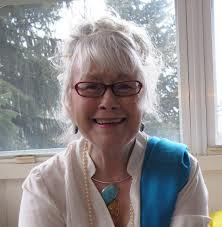 Hi, Kaye! Nice to see you again on the blog.
Hi, Kaye! Nice to see you again on the blog.
Hi, Julia – Thanks so much for having me back.
Your writer friends have been telling you for years to write a book. Not until recently did you take them up on the challenge. What made you sit down to write Whimsey, your self-published book?
They have been, haven’t they? Especially a couple in particular – Judith Greber and Earl Staggs. Judith with gentle nudges, Earl – eh, not so gently. (I’m teasing about Earl - sorta). But after I retired I decided it was now or never and I wanted to see if I could actually write the book I wanted to write. It took a couple years, but with Earl’s patient guidance, holding my hand and teaching me every step of the way, along with excellent editing on his part, I wrote the book that was living in my head and in my heart and I’m proud of it.
You live in Boone, North Carolina, but the island of Whimsey is located off of Georgia. How did you decide upon the setting?
I love these North Carolina mountains, but I think by growing up on the water that’s where my heart is. I find magic when I’m near the ocean and it just wouldn’t be “my” book if I tried to place the story anywhere else.
Whimsey the island is a place that celebrates the arts. Was there, for you, a sort of Renaissance feeling to this creation?
I wanted WHIMSEY to celebrate many things. Connections for one, thus the strong family and friendship storyline that runs through the novel. Beauty for another, and that’s where the artsy things came into play. I’m a lover of beautiful things, and having these women who have been friends since they were little girls creating beautiful things just felt right to me. The renaissance may be in the rebirth of a talent thought lost by the protagonist, Emma, but truthfully, a renaissance for me--I’m not so sure. An “awakening” of a talent, then yes, probably so. I love the title, not only because it sums up the tone of the book but because it reminds me of Lord Peter Wimsey and of all things whimsical. What came first: your idea for a title, or your idea for a plot?
The idea for the story came first – and I wrote a lot of it before Earl said, “Kaye, this is lovely, but you don’t have a plot.” By then the name WHIMSEY was just there. I have no idea where it came from, it was just there. And I think it’s perfect and I love it and the name Whimsey, honestly, helped spark a lot of what happens through the book. With a different title, even a working title, I don’t think the same book would have emerged. I’ve always tried to live my own life with a bit of whimsy – right down to decorating our home with surprise touches of playful and whimsical things sitting around. I’m sure it drives some people a little crazy when they walk in the door, and I sometimes think I’m going to try decorating the house like a grown-up and I try, but those “things” just seem to find their way back. And having Lord Peter Wimsey as a long time “friend” was part of the mix also.
You recently retired. What’s the best thing about retired life? Are you reading a lot more than you did before?
I love being retired. I now believe I was born to be a retired person. When I was younger my interests were SO different than they are now. I had years of working in an office in jobs that offered little in the way of creative outlets. I’ve taken a beezillion classes in lots of different areas – I’ve taken basketweaving, knitting, pottery, weaving, jewelry making, and I’m sure there are others I’m forgetting. Some were more successful than others, but all were precluded by the fact that I had a “job.” That job made a difference. While none of the jobs have been bad, just the very fact of them seemed to suck up the time and the inclination to spread my wings and do more. Once I retired I promised myself I would do the things I didn’t feel as though I had the time for while working. The best thing is that time. Time is my most cherished possession now and I try to use it in ways that are productive and bring me joy. I am not reading as much as I did. I’m still reading a lot and I still love it, but now there are other joys in addition to my books.
What made you decide to self-publish instead of going the route of querying agents or publishers?
I did it for a number of reasons, and it's working for me, but it's not for everyone. The whole two years I was working on WHIMSEY, I had intended to try to publish traditionally. I did my research, I made lists of agents and editors of some of my favorite authors (the acknowledgements in books by your favorite writers is an excellent source for this type of information). But when I was finally finished and when Earl Staggs, who edited WHIMSEY, agreed that it was finally finished, the traditional route suddenly wasn't as important to me as it had been in the beginning.
What was important to me now was getting it out there. I personally think, for one thing, that starting out in the traditional way is now a young person's game and I'm not a young person and I'm not a patient person. And, truthfully, I wanted my mother to be able to read “Whimsey” and see it as a "real" book.
A more lengthy answer to your question, IFanyone is interested in here: http://www.meanderingsandmuses.com/2013/01/why-ive-decided-to-self-publish.html
In addition to the blog I wrote about why I made the decision I did (see above), I've also written a piece about the self-publishing process, and you can read it here - http://www.meanderingsandmuses.com/2013/03/what-ive-learned-so-far-about-being.htmlhttp://www.meanderingsandmuses.com/2013/03/what-ive-learned-so-far-about-being.html
Are you thinking of writing a sequel to Whimsey?
Actually, my plan is to write four more WHIMSEY books. There are five women (The Wicked Women of Whimsey). WHIMSEY: A NOVEL focused on Emma. Book #2, which I’m working on, will focus on Olivia.
One of your glowing reviews praises the descriptions of food in your novel. What was the food description that was the most fun to write?
I love to eat. I wish I loved to cook as much as I love to eat. But some of my loveliest times seem to involve nice meals shared with good friends. Hanging around in their kitchens, sitting around tables. I don’t think Donald and I have ever taken a trip that we don’t seem to gauge it by how well we ate. So, there’s a lot of that in WHIMSEY. I think one of my favorite scenes is one where most of the book’s characters are gathered for a “breakfast for dinner” being whipped up by Emma’s mother, Zelda.
What did your husband and canine companions do when you were answering your writing Muse? Did they miss you while you typed away?
Donald Barley is so good. He has encouraged my writing since the very first piece I wrote in 2008 – a blog for The Stiletto Gang about my efforts to quit smoking. He’s always been there for me to bounce ideas off when I write at Meanderings and Muses, and he encouraged me to write yjr pieces which I was thrilled to have accepted for two regional anthologies.
While I was writing WHIMSEY and we would talk on the phone during the day he would ALWAYS ask, “Are you working?” and if I wasn’t, he would nudge me a bit.
Harley? Now that’s a different story. Harley makes the rules, and if it’s time for walkies, well – it’s time for walkies.
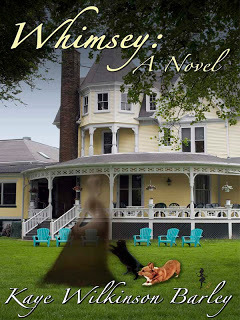
That seems pretty dog-like, yes. :)
Has Spring come to Boone? If so, what does spring look like there?
Spring? NO! Is it ever coming??? We’re expecting snow this week. How ‘bout you? Are you beginning to see lovely spring flowers?
Actually, it's cold in Chicago, too. We had an entire March without any temperatures in the 60s, and April has been mostly that way, too!
If you could go to Whimsey, what’s the first thing you would do there?
I would go sit on the beach and watch the sunrise.
Aah. Where can readers find out more about Whimsey and Kaye Barley?
I talk about WHIMSEY endlessly. Everywhere. If you’re at Facebook, I’m there – a lot. But here’s the WHIMSEY webpage which includes a schedule of blogs where I’ll be popping up. It also includes the first chapter of the book. http://www.kayewilkinsonbarley.com/ AND, I’m the blog mistress of Meanderings and Muses - http://www.meanderingsandmuses.com/. AND the very cool women at Jungle Red Writers let me pop in to play the first Sunday of each month - http://www.jungleredwriters.com/
Thanks for chatting, Kaye!
Julia, Thank You! It’s always fun to spend a little time with you, my friend.

Published on April 07, 2013 23:00
March 20, 2013
Parker Francis on History, Mystery and Mythological Retribution
Parker Francis is the author of Matanzas Bay and Bring Down the Furies, which The Kindle Book Review called "intriguing, engaging, and suspenseful."

Your title references the Furies, who are mythological creatures of retribution. Are you a fan of mythology, or just the Furies? :)
In Greek mythology, the Furies were the three goddesses of vengeance. I can’t say I’m a big fan of mythology, but vengeance and justice are themes that play themselves out in my Quint Mitchell books as Quint always tries to do the right thing although he might take a roundabout route to get there.
Quint Mitchell is a great name for a detective. Is he a fifth son?
Quinton “Quint” Mitchell is actually the first son in his family. In the first Quint Mitchell Mystery, MATANZAS BAY, the reader learns more of his backstory and family history. In that book Quint is in a darker place, carrying a load of guilt that stems from the death of younger brother. But I’m glad you like the name. Writers, as you know, strive to find a name that will resonate with the reader and carry the character through the book.
Quint has a likeable style; he’s hard-boiled, but he has a softer side. Who are the hard-boiled detectives you most admire?
The hard-boiled detective has been a staple of American mysteries going back to the pulps. Authors I’ve admired, like Dashiell Hammett and Raymond Chandler, brought us Sam Spade and Philip Marlowe. Mickey Spillane followed with his Mike Hammer tough guy series, but I absolutely loved John D. Macdonald, who gave us the Travis McGee novels, which I still consider among the best in the genre. Because I’m a real softie, I wanted to give Quint a softer, more human side and not make him into an indomitable superhero who can whip six men with one hand tied behind his back. This means he makes mistakes once in a while and might have misgivings about the choices he makes. This is beginning to sound like my autobiography.
Haha! One of Quint’s tasks in the book is to catch a womanizing con artist called “The Heartthrob Bandit.” Is this criminal based on any real-life gigolo?
Ricardo “Ricky” DeAngelis was one of my favorite characters in the book. I’m sure I must have heard or read a news account of a con man preying on older wealthy women somewhere along the way, but Ricky was pretty much born of my warped imagination. I really didn’t envision him playing a major role in the story and used him mainly as a device to get Quint from Jacksonville Beach to Allendale, SC. But once he and Quint met in the first chapter, Ricky became a major subplot while Quint coped with the serial arsonist.
In addition to your mythological allusions, your book makes several historical allusions, as well. Are you a history buff?
History was one of my favorite subjects in school, so I guess you can say I’m a bit of a history buff. I’d like to think that readers of mysteries are looking for more than just crime and punishment. They want to learn something as they try to solve the mystery, so I like to salt my fiction with historical facts. In BRING DOWN THE FURIES we learn a little about the history of Allendale, and how General Sherman’s troops burned down the original town during the Civil War. Matanzas Bay was set in St. Augustine, Florida, and readers were exposed to some of the colorful and bloody history of the nation’s oldest city.
 What made you set the story in South Carolina?
What made you set the story in South Carolina?
After MATANZAS BAY I wanted to move Quint to another location. I also wanted find a setting where archaeology might play a part in a larger mystery, as it did in the first offering. Searching the Internet, I located a listing of archaeological projects in the southeast. That led me to the Topper site outside Allendale, South Carolina where Dr. Albert Goodyear has found artifacts made by the pre-Clovis people dating back thousands of years. Claxons began ringing in my head, and I asked myself what if a Creationist minister feuded with the archaeologist and it boiled over into a tension-filled media circus. Now I felt I was onto something that could explode from a single idea into a longer, more compelling narrative. With more research I learned that General Sherman’s troops had burned down the original town on their way to Columbia during the Civil War. This bit of historical news tripped another set of creative neurons and I decided fire would play a major role in the story. That led to the idea of a serial arsonist at work in Allendale.
In addition to the Quint mysteries, you’ve written books with a feline protagonist in your WINDRUSHER series. Was it hard to get the cat’s point of view just right?
It was, but having lived for years with a household overflowing with feline critters I had plenty of role models. They were also very strict editors who made sure I got it right. Seriously, though, it was a bit tricky, but once I got inside my protagonist’s head it became much easier. The WINDRUSHER trilogy was fun to write, and I still hear from readers wondering when the next one will come along.
Speaking of cats, your website informs me that one of your own cats, Duke, is quite the critic of manuscripts. Does he help you polish drafts?
Wow, you’ve really done some digging. Duke has a habit of tap dancing across my keyboard when I’m writing. He isn’t as bad as he once was and will usually settle down in my lap for nap after he’s done his damage. He’s a bit of a bully who keeps the other cats at bay, but he’s really a pussycat at heart.
Will there be more Quint Mitchell books?
Yes there will. The next novel is in development stage (by which I mean I’m still in the daydreaming process) and will bring Quint back to Florida. This one will be set in Cedar Key on Florida’s west coast. Right now I’m readying a short story collection I’ve titled GHOSTLY WHISPERS, SECRET VOICES, containing six surprising and darker stories. This will be available for Kindle readers within the next month or so.
What are you reading right now?
I’m a major consumer of books in any form. I have two “tree books” going right now. The Yard by Alex Grecian, which is a mystery set in Victorian England shortly after Jack the Ripper terrorized London. The other is Laura Smith’s debut novel, Heart of Palm, which won’t be out until April, but her publisher sent me an advance copy. It’s funny and warm and I’m enjoying it. On my iPad Kindle app I’m reading Paul Levine’s Fool Me Twice, a Jake Lassiter mystery, and in my car I’m listening to one of Lee Child’s Jack Reacher books, Echo Burning. I also have a few books on my iPhone that I listen to while working out or pulling weeds from my lawn, which is a redundancy since my lawn is mostly weeds.
If Hollywood made a movie of your book, who would you want cast as Quint?
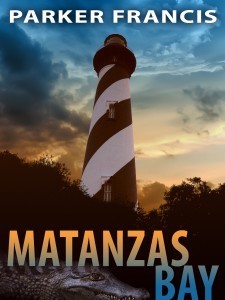 Good question. There are a few who fit my image for Quint Mitchell, including Leonardo DiCaprio, KyleChandler and Mark Ruffalo. If Alec Baldwin was 15 years younger he’d be perfect. But while we’re dreaming of casting actors for my “movie,” how about these other characters: Sheriff Wilburn Peeks plays a major part in FURIES as the tough-talking adversary who gives Quint a hard time for much of the story. Of course, I’d love to see Tommy Lee Jones play the crusty sheriff after seeing his remarkable portrayal of Thaddeus Stephens in “Lincoln.” I can also envision Ed Harris in the role. One more role I’d fill would be Nurse Allene Skinner-Jarrett. Allene plays Quint’s love interest, or perhaps lust interest would be more accurate. She’s a bit of a tease, but exudes sensuality and knows how to push Quint’s buttons. I can picture Charlize Theron or Jennifer Garner slipping into (and out of) her medical scrubs to treat Quint.
Good question. There are a few who fit my image for Quint Mitchell, including Leonardo DiCaprio, KyleChandler and Mark Ruffalo. If Alec Baldwin was 15 years younger he’d be perfect. But while we’re dreaming of casting actors for my “movie,” how about these other characters: Sheriff Wilburn Peeks plays a major part in FURIES as the tough-talking adversary who gives Quint a hard time for much of the story. Of course, I’d love to see Tommy Lee Jones play the crusty sheriff after seeing his remarkable portrayal of Thaddeus Stephens in “Lincoln.” I can also envision Ed Harris in the role. One more role I’d fill would be Nurse Allene Skinner-Jarrett. Allene plays Quint’s love interest, or perhaps lust interest would be more accurate. She’s a bit of a tease, but exudes sensuality and knows how to push Quint’s buttons. I can picture Charlize Theron or Jennifer Garner slipping into (and out of) her medical scrubs to treat Quint.
You live in Florida. Will you ever set a book there? See the answers to the above questions regarding Matanzas Bay and book three in the series. I think Quint will always come back to Florida as long as I’m here to greet him.
Thanks for chatting, Parker!!
Thank you, Julia. I appreciate the opportunity to share with your readers.


Your title references the Furies, who are mythological creatures of retribution. Are you a fan of mythology, or just the Furies? :)
In Greek mythology, the Furies were the three goddesses of vengeance. I can’t say I’m a big fan of mythology, but vengeance and justice are themes that play themselves out in my Quint Mitchell books as Quint always tries to do the right thing although he might take a roundabout route to get there.
Quint Mitchell is a great name for a detective. Is he a fifth son?
Quinton “Quint” Mitchell is actually the first son in his family. In the first Quint Mitchell Mystery, MATANZAS BAY, the reader learns more of his backstory and family history. In that book Quint is in a darker place, carrying a load of guilt that stems from the death of younger brother. But I’m glad you like the name. Writers, as you know, strive to find a name that will resonate with the reader and carry the character through the book.
Quint has a likeable style; he’s hard-boiled, but he has a softer side. Who are the hard-boiled detectives you most admire?
The hard-boiled detective has been a staple of American mysteries going back to the pulps. Authors I’ve admired, like Dashiell Hammett and Raymond Chandler, brought us Sam Spade and Philip Marlowe. Mickey Spillane followed with his Mike Hammer tough guy series, but I absolutely loved John D. Macdonald, who gave us the Travis McGee novels, which I still consider among the best in the genre. Because I’m a real softie, I wanted to give Quint a softer, more human side and not make him into an indomitable superhero who can whip six men with one hand tied behind his back. This means he makes mistakes once in a while and might have misgivings about the choices he makes. This is beginning to sound like my autobiography.
Haha! One of Quint’s tasks in the book is to catch a womanizing con artist called “The Heartthrob Bandit.” Is this criminal based on any real-life gigolo?
Ricardo “Ricky” DeAngelis was one of my favorite characters in the book. I’m sure I must have heard or read a news account of a con man preying on older wealthy women somewhere along the way, but Ricky was pretty much born of my warped imagination. I really didn’t envision him playing a major role in the story and used him mainly as a device to get Quint from Jacksonville Beach to Allendale, SC. But once he and Quint met in the first chapter, Ricky became a major subplot while Quint coped with the serial arsonist.
In addition to your mythological allusions, your book makes several historical allusions, as well. Are you a history buff?
History was one of my favorite subjects in school, so I guess you can say I’m a bit of a history buff. I’d like to think that readers of mysteries are looking for more than just crime and punishment. They want to learn something as they try to solve the mystery, so I like to salt my fiction with historical facts. In BRING DOWN THE FURIES we learn a little about the history of Allendale, and how General Sherman’s troops burned down the original town during the Civil War. Matanzas Bay was set in St. Augustine, Florida, and readers were exposed to some of the colorful and bloody history of the nation’s oldest city.
 What made you set the story in South Carolina?
What made you set the story in South Carolina?
After MATANZAS BAY I wanted to move Quint to another location. I also wanted find a setting where archaeology might play a part in a larger mystery, as it did in the first offering. Searching the Internet, I located a listing of archaeological projects in the southeast. That led me to the Topper site outside Allendale, South Carolina where Dr. Albert Goodyear has found artifacts made by the pre-Clovis people dating back thousands of years. Claxons began ringing in my head, and I asked myself what if a Creationist minister feuded with the archaeologist and it boiled over into a tension-filled media circus. Now I felt I was onto something that could explode from a single idea into a longer, more compelling narrative. With more research I learned that General Sherman’s troops had burned down the original town on their way to Columbia during the Civil War. This bit of historical news tripped another set of creative neurons and I decided fire would play a major role in the story. That led to the idea of a serial arsonist at work in Allendale.
In addition to the Quint mysteries, you’ve written books with a feline protagonist in your WINDRUSHER series. Was it hard to get the cat’s point of view just right?
It was, but having lived for years with a household overflowing with feline critters I had plenty of role models. They were also very strict editors who made sure I got it right. Seriously, though, it was a bit tricky, but once I got inside my protagonist’s head it became much easier. The WINDRUSHER trilogy was fun to write, and I still hear from readers wondering when the next one will come along.
Speaking of cats, your website informs me that one of your own cats, Duke, is quite the critic of manuscripts. Does he help you polish drafts?
Wow, you’ve really done some digging. Duke has a habit of tap dancing across my keyboard when I’m writing. He isn’t as bad as he once was and will usually settle down in my lap for nap after he’s done his damage. He’s a bit of a bully who keeps the other cats at bay, but he’s really a pussycat at heart.
Will there be more Quint Mitchell books?
Yes there will. The next novel is in development stage (by which I mean I’m still in the daydreaming process) and will bring Quint back to Florida. This one will be set in Cedar Key on Florida’s west coast. Right now I’m readying a short story collection I’ve titled GHOSTLY WHISPERS, SECRET VOICES, containing six surprising and darker stories. This will be available for Kindle readers within the next month or so.
What are you reading right now?
I’m a major consumer of books in any form. I have two “tree books” going right now. The Yard by Alex Grecian, which is a mystery set in Victorian England shortly after Jack the Ripper terrorized London. The other is Laura Smith’s debut novel, Heart of Palm, which won’t be out until April, but her publisher sent me an advance copy. It’s funny and warm and I’m enjoying it. On my iPad Kindle app I’m reading Paul Levine’s Fool Me Twice, a Jake Lassiter mystery, and in my car I’m listening to one of Lee Child’s Jack Reacher books, Echo Burning. I also have a few books on my iPhone that I listen to while working out or pulling weeds from my lawn, which is a redundancy since my lawn is mostly weeds.
If Hollywood made a movie of your book, who would you want cast as Quint?
 Good question. There are a few who fit my image for Quint Mitchell, including Leonardo DiCaprio, KyleChandler and Mark Ruffalo. If Alec Baldwin was 15 years younger he’d be perfect. But while we’re dreaming of casting actors for my “movie,” how about these other characters: Sheriff Wilburn Peeks plays a major part in FURIES as the tough-talking adversary who gives Quint a hard time for much of the story. Of course, I’d love to see Tommy Lee Jones play the crusty sheriff after seeing his remarkable portrayal of Thaddeus Stephens in “Lincoln.” I can also envision Ed Harris in the role. One more role I’d fill would be Nurse Allene Skinner-Jarrett. Allene plays Quint’s love interest, or perhaps lust interest would be more accurate. She’s a bit of a tease, but exudes sensuality and knows how to push Quint’s buttons. I can picture Charlize Theron or Jennifer Garner slipping into (and out of) her medical scrubs to treat Quint.
Good question. There are a few who fit my image for Quint Mitchell, including Leonardo DiCaprio, KyleChandler and Mark Ruffalo. If Alec Baldwin was 15 years younger he’d be perfect. But while we’re dreaming of casting actors for my “movie,” how about these other characters: Sheriff Wilburn Peeks plays a major part in FURIES as the tough-talking adversary who gives Quint a hard time for much of the story. Of course, I’d love to see Tommy Lee Jones play the crusty sheriff after seeing his remarkable portrayal of Thaddeus Stephens in “Lincoln.” I can also envision Ed Harris in the role. One more role I’d fill would be Nurse Allene Skinner-Jarrett. Allene plays Quint’s love interest, or perhaps lust interest would be more accurate. She’s a bit of a tease, but exudes sensuality and knows how to push Quint’s buttons. I can picture Charlize Theron or Jennifer Garner slipping into (and out of) her medical scrubs to treat Quint.You live in Florida. Will you ever set a book there? See the answers to the above questions regarding Matanzas Bay and book three in the series. I think Quint will always come back to Florida as long as I’m here to greet him.
Thanks for chatting, Parker!!
Thank you, Julia. I appreciate the opportunity to share with your readers.

Published on March 20, 2013 06:32
January 24, 2013
New Paths
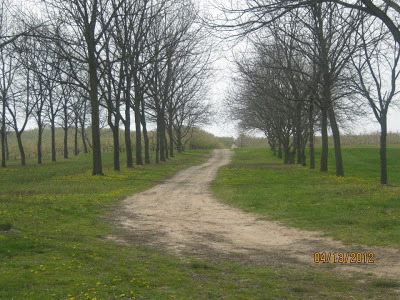
New Year's Resolutions are so necessary, but so difficult! How are your resolutions going?I'm still swearing to "get on a program," but my fitness level leaves a lot to be desired.
However, I am on target for reading more books this year! Three good ones I just read are
Mr. Penumbra's 24-Hour BookstoreThe Age of MiraclesGone Girl
All disparate titles, but all interesting and well-written. I'm guessing they're all destined to be turned into movies. What good books have you read lately?
Good luck with your own New Year's resolutions! It's still January, after all. We can still make them happen. :)

Published on January 24, 2013 19:24
December 24, 2012
Merry Christmas, Happy Hanukkah, Happy New Year
Published on December 24, 2012 08:58
November 30, 2012
A Craig Johnson Christmas
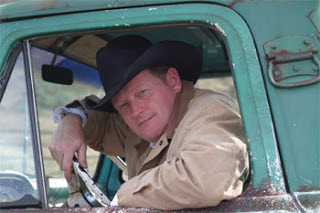 As a Craig Johnson fan, I was pleased to hear this announcement from Penguin:
As a Craig Johnson fan, I was pleased to hear this announcement from Penguin:On December 4, 2012 Penguin will release CHRISTMAS IN ABSAROKA COUNTY ($3.99; ISBN: 978-1-10163471-8) an original eSpecial story collection by New York Times bestselling author Craig Johnson.
In CHRISTMAS IN ABSAROKA COUNTY, readers glimpse a softer side of Walt Longmire, the longtime sheriff of Absaroka County, Wyoming, as he grapples with the death of his wife Martha and his sometimes turbulent, but ever-loving relationship with his daughter Cady. In these four stories: Ministerial Aid, Slick-Tongued Devil, Toys for Tots, and Unbalanced, Walt is alternately at his best and his worst. He helps a possibly delusional elderly victim of domestic abuse while sporting a bath robe and a mean hangover on New Year’s Day. He’s sidelined by grief when his wife’s obituary appears in the paper and there’s an unexpected knock on his door, two-days before Christmas. He strives to help even those who don’t want it when he picks up a young female hitchhiker and he’s forced into some last-minute Christmas shopping by the Greatest Legal Mind of Our Times, during which he might just end up saving a young Marine chaplain’s Christmas.
So the holidays have come a little early! I think this might be a nice download for my Kindle--and maybe I'll give it to myself.

Published on November 30, 2012 15:43
November 20, 2012
Thanksgiving Thoughts
Published on November 20, 2012 14:46
October 27, 2012
Terri L. Austin on Waitresses in Diners, Nerds Who Speak Klingon, and Movies So Bad That They're Good
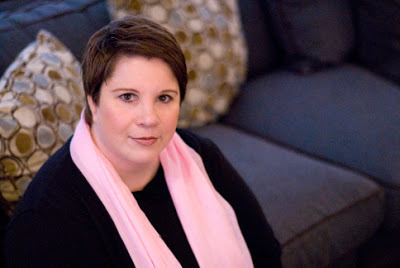 Thanks for chatting, Terri.
Thanks for chatting, Terri.Your book is called DINERS, DIVES and DEAD ENDS. So what came first, the title or the idea for the mystery?
First of all, thanks for having me on your blog, Julia! It’s a pleasure to be here.
The book came first. My editor and I cooked up the title. Originally, I had something different in mind, but I think Diners, Dives and Dead Ends sums up the novel pretty well.
Your heroine, Rose Strickland, works at a diner and has a sassy attitude. Were you at all inspired by the tv show Alice?
No, but that’s a great show! I made Rose a waitress because I wanted her to be a bit of an underdog who is struggling to make ends meet. Also, working at a diner that is only open for breakfast gives her flexibility to solve mysteries in her spare time!
Your characters have great names. Ax Graystone is one of my favorites. Do you spend a lot of time thinking of them, or do they just pop into your head?
Sometimes they suddenly come to me, but most of the time I give names a lot of thought. Names are important, giving the audience insight into the character’s standing, background, and place in life. But then I like turning those notions upside down. Ax was fun to play with. He has this very unusual name, Axton Graystone—an old family name—but he doesn’t live up to his family’s expectations at all. Rosalyn Strickland is a very proper, straight-laced name. But she insists on being called Rose and is anything but demure.
True ! You reference a lot of movies in the book, and in your author comments you say that you love watching “really bad movies.” What makes bad movies good? Do you and Rose Strickland share this feeling?
I think Rose is stuck watching bad sci-fi movies with Ax. She wouldn’t go out of her way to watch a bad movie on her own. Me? I love nothing better than a cheesy movie. I just watched Surf Party the other day, with Bobby Vinton. It was awful, but awesomely so. The bad acting, the silly plot, the horrible, faux beach songs. I couldn’t get enough. I’m weird like that. Give me an MST3K movie and a bowl of popcorn, and I’m pretty happy.
MST3K is the greatest! Are there any other attitudes or ideas that you share with your heroine?
Some Rose-isms might pop out of my mouth from time to time. But my attitude is probably more in line with Roxy. She’s blunt, snarky, and doesn’t have much of a filter from her brain to her mouth.
Have you ever worked at a diner?
No, but I’ve eaten in a lot of them! When I go to my local diner, I watch the waitresses hustle to help customers. The way they whip those huge trays around is like choreography. I don’t think I’m coordinated enough to do that without breaking a lot of plates. I’m not sure I’d make it after the first shift.
It certainly is an undersung profession. Rose is fairly young, as heroines go. What made you decide on a 24-year-old narrator?
I wanted Rose to have been away from her parents for a few years, but not too many. This way I could show the reader what her life is like. This isn’t a trial run for Rose, this is her reality. And she’s stuck. She’s been on her own for five years, and she still isn’t sure about her future or her education. The mid-twenties are a time of self-discovery. Rose is a conflicted character who is still trying to find herself.
You have a lot of strong women in this novel. Did you create them consciously, or is it just instinctive for you to write women smart and sassy?
I like smart, sassy women, so I guess it comes naturally to me. I love snappy dialogue and creating distinctive characters. To me, Rose, Roxy, and even Ma are women flying solo and making their own way in the world.
Rose is twenty-four, and since her lawyer friend Dane was in her eighth grade class, that makes him twenty-four, too. Can you already be an experienced lawyer at twenty-four years old?
I don’t consider Dane to be experienced. He has a foot in the door with a good firm and he’s been blessed with family connections. Now he’s out to prove he’s up to the task. He’s definitely a contrast to Rose. Dane knows what he wants and he’s determined to achieve it. Rose is floundering, unsure of what her next step should be. I like the dichotomy between the two characters.
Whenever Rose mentions the flapjacks at her diner, I want to eat pancakes. Did you ever consider doing a signing at a diner?
I would love to do a signing at a diner! Just the smell of coffee makes me swoon. Add the smoky smell of bacon, and I’d be in heaven.
Ax is a real sci-fi nerd, loving everything from Star Wars to comic books. Do you have an Ax in your own life?
My husband is an engineer and loves sci-fi movies, so I guess I drew a little inspiration from him. But Axton takes it to a whole different level. He’s fluent in Klingon, he owns action figures, and he collects graphic novels. Axton lives in his own little world and I enjoy that about him.
You mention in your acknowledgements that your husband Jeff made dinner while you wrote. My husband Jeff is also the dinner maker in the family. What would we do without our Jeffs?
Go hungry! My Jeff has been a rock and my biggest champion. We’ve been married for 23 wonderful years and I’d be lost without him. And he makes omelets that rock my morning.
So wonderful! Will there be more novels in the Rose Strickland series?
The second Rose mystery, Last Diner Standing, is coming out December 3rd. I’m very excited about it. Ma is on a rampage with a rival diner. We get to see more of the quirky characters that inhabit Rose’s world and quite a bit more of Rose’s bad guy crush. And it’s a Christmas mystery, which was a ton of fun to write.
That sounds great! Thanks for talking with me, Terri, and good luck with the book!
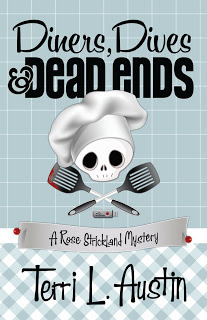
Thanks for having me, Julia! It was fun.
More about Terri's book:
Diners, Dives and Dead EndsA Rose Strickland MysteryBy Terri L. Austin 978-1938383007Henery Press
As a struggling waitress and part-time college student, Rose Strickland’s life is stalled in the slow lane. But when her close friend, Axton, disappears, Rose suddenly finds herself serving up more than hot coffee and flapjacks. Now she’s hashing it out with sexy bad guys and scrambling to find clues in a race to save Axton before his time runs out.
With her anime-loving bestie, her septuagenarian boss, and pair of IT wise men along for the ride, Rose discovers political corruption, illegal gambling, and shady corporations. She’s gone from zero to sixty and quickly learns when you’re speeding down the fast lane, it’s easy to crash and burn. Amazon, Kobo, B&N
Terri L. Austin lives in Missouri with her funny, handsome husband and a high maintenance peekapoo. She loves to hear from readers. Find her on Twitter, FB, TerriLAustin.com, Goodreadsand Henery Press. She and her writer friends have a book chat every Wednesday on Little Read Hens. Check it out and join in the conversation!

Published on October 27, 2012 10:04





